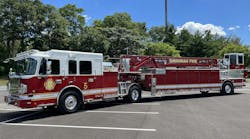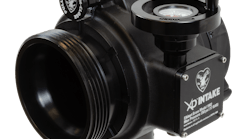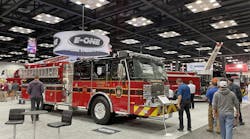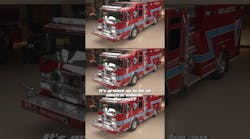Dr. Burt Clark of the National Fire Academy, kindly asked me to share with you the financial penalties that can be imposed on a fire department in Ohio if a firefighter is ejected and killed in a rollover accident, and subsequent investigation shows that the fire chief or the department's officers do not strictly enforce the seat belt policy. This is a "hypothetical" case - the good news is that while there have been several safety violation claims filed against Ohio fire departments, we are not aware of any claim arising from failure to wear a seat belt.
Hypothetical: A 40-year-old, full-time firefighter, driving a water tanker to a structure fire, loses control and is ejected and killed when the tanker rolls. His widow, also age 40, with two children, learns from fellow firefighters that few firefighters or officers wear seat belts on this department. While there is a written policy requiring seat belts be worn, no one has ever been disciplined and the seat belt policy is simply ignored by most, including her late husband.
Ohio VSSR Penalties ($630,000 first offense; $315,000 second offense, plus $50,000 if within two years): Under Ohio law, a VSSR ("Violation of Specific Safety Requirement") claim can result in an added award to an injured employee, or to their survivor. Every dollar paid to the employee or survivor is billed back to the employer, as a "penalty" for violating the safety requirement. The VSSR program is designed to "encourage" employers to avoid penalties by enforcing the safety regulations.
Under the hypothetical, the widow of the deceased firefighter can file a VSSR claim online with the Industrial Commission of Ohio(click on forms "Application for Additional Award for Violation of Specific Safety Requirement in a Workers' Compensation Claim - form IC-8/9). The VSSR award can be from 15 to 50 percent of the Ohio Average Weekly Wage (AWW) and the AWW is currently $751 per week. In death cases, VSSR claims typically result in the maximum 50 percent award. The widow will receive payments for the rest of her life, so long as she does not remarry. If she does remarry, then the children receive the payments until age 18, or until age 23 if still in school full-time. The employer is then invoiced by the Industrial Commission of Ohio, dollar for dollar for each payment to the widow.
Seat Belt Requirement: Ohio has a specific safety requirement on firefighters wearing seat belts. The employer can be penalized for failure to enforce. The individual employee is not subject to any State of Ohio penalties by these regulations.
Ohio Administrative Code 4123:1-21-04(5)(b) provides:
"Employees shall be required to be seated and belted while the apparatus is in motion, except while loading hose."
Effective Nov. 1, 2003, Ohio issued a completely updated set of specific safety requirements for firefighting. These regulations were drafted with the assistance of representatives from the Ohio Fire Chiefs Association, the Ohio Rural Fire Council, and the Ohio Professional Firefighters Association.
VSSR Investigation: Paragraph 6 of the IC-8/9 form asks for the names, addresses, and phone numbers of witnesses. The widow should list as many firefighters as possible who will confirm that they do not wear seat belts on emergency runs, and also the names of fire department officers who also do not wear seat belts and don't enforce the department's seat belt written policy.
Ohio VSSR investigators will privately contact these firefighters and get their sworn affidavits and in some cases they will also conduct group and individual videotaped interviews. The VSSR investigators will then come to the fire department, unannounced, and seek to interview the fire chief and the officers.
Caution - Perjury: If the VSSR claim is not settled for a lump sum with the widow (see Form IC 10), and the fire chief and officers are called to testify before a hearing officer of the Industrial Commission of Ohio, their testimony can lead the hearing officer to conclude that the department violated the seat belt safety requirement. Individually, the results can be far more drastic. Their false statements can be referred to a county prosecutor, who can ask a grand jury to indict them for perjury. If convicted, they face jail time, substantial fines, and termination from the fire department!
VSSR Penalty: $630,000 - William Garver, Manager of the Ohio VSSR Investigations Unit kindly provided the following:
Hypothetically, if a 40-year-old firefighter were to die today after being ejected from the truck, his widow could potentially be entitled to a substantial VSSR award if the IC-9 application cited 4123:1-21-04(5)(b) seat belt required. In this scenario, Ohio's current Average Weekly Wage (AWW) is set at $751.00 per week. Let's say the widow is 40 years of age as well. Her life expectancy is say, 75 years. If successful in the VSSR, she would be entitled to 35 years of VSSR comp. at a maximum of 50 percent additional award allowance rate (50 percent of the AWW at the time of death). Historically, fatal VSSR awards are granted at the maximum or 50 percent. So, 50 percent of $751.00 is $375.50 per week, times 35 years = $630,840.00. As long as the widow does not remarry, she would continue to receive the VSSR award.
VSSR Additional Penalty: $315,000 penalty, plus $50,000: The Industrial Commission of Ohio will issue an "Order of Correction" to the fire department.
Ohio VSSR investigators will return to the fire department to see if they are now following the seat belt safety requirement. A second VSSR violation can result in an additional penalty of 50 percent of the first VSSR, and if this second VSSR violation occurred within two years of the first, the fire department can be hit with an additional $50,000 fine.
Normal Workers' Comp Award: $672,000 - The VSSR claim is for an additional award under Ohio Workers Comp. What about the widow's regular worker's compensation claim?
Bill Garver kindly did the math:
Using the same scenario, and the widow never remarries, she would be entitled to death benefits for the remainder of her life (75 year expectancy). Death benefits are payable at 66.66 percent of the decedent's AWW (not the state determined/set AWW, utilized in tabulating VSSRs), but not less than 50 percent of the state set AWW. For this scenario, let's say the decedent earned $600.00 per week. 66.66 percent of that amount is approximately $400.00. $400.00 per week x 35 years = $672,000.00. Also, keep in mind that the widow will also be entitled to funeral expenses up to $5,500.00.
Other Financial Matters - Ohio and Federal LODD Benefits
Under the hypothetical, the widow of the full-time firefighter will also be entitled to death benefits under the Ohio Police & Fire Pension Fund or Ohio Public Employee Retirement System, as well as federal line-of-duty-death benefits, under Public Safety Officers' Benefits program, administered by the U.S. Department of Justice.
Ohio Civil Lawsuits - Damages Reduced By Failure To Wear Seat Belt: If you are injured in a motor vehicle crash, through no fault of your own, an Ohio law enacted in 2005 will adversely impact your jury verdict if you were not wearing a seat belt. Likewise, if an Ohio firefighter is injured riding in an emergency vehicle on an emergency run because a civilian driver pulled out in front of the apparatus, the injured firefighter's recovery in a private lawsuit against the civilian driver will be affected.
The Ohio General Assembly in 2005 passed a law to "encourage" all motorists to wear seat belts. The jury will be instructed to reduce the award to the injured driver or passenger to the extent his injuries were caused or enhanced by his failure to wear a seat belt. The Ohio Tort Reform Act, Amended Senate Bill 80, effective April 6, 2005, requires judges to instruct juries that they may determine "that the failure [to wear seat belt] contributed to the harm alleged in the tort action and may diminish a recovery of compensatory damages that represent the noneconomic loss."
OSHA - Seat Belt Citations: Federal OSHA does not have jurisdiction over state and local governmental agencies, including fire departments. They do have jurisdiction over private fire companies in 26 federal-OSHA states. In 24 other states, including Kentucky, there are state-OSHA plans. These state agencies do enforce state safety regulations against public and private fire departments. The citations can be sizable (even if the final settlement amount is substantially less), and the publicity concerning these citations can have a negative impact on fire levies, and the careers of the senior fire officials involved.
OSHA does not have a specific regulation on seat belts; instead OSHA relies on its Personal protective equipment regulation, 29 CFR 1926.28, to issue citations and fines against private employers for not enforcing seat belts. For example, OSHA issued a $77,000 citation against Anderson Columbia Company, Lake City, FL when an employee fell to his death from the back of a pickup truck while placing traffic warning signs on a roadway warning of pipeline installation ahead.
29 CR 1926.28(a) provides: "The employer is responsible for requiring the wearing of appropriate personal protective equipment in all operations where there is an exposure to hazardous conditions or where this part indicates the need for using such equipment to reduce the hazards to the employees."
Criminal Prosecutions: Increasingly, throughout the nation, prosecutors are bringing felony charges against individuals for allegedly causing the death of others. It is definitely possible that criminal charges could be brought against a Fire Department officer where that officer advises his crew members to disregard seat belt rules, and this direction leads to the death of a firefighter. Two recent examples of criminal prosecutions related to firefighter deaths are as follows.
On March 3, 2008, the Bronx, NY prosecutor brought charges against a building engineer, concerning the August 2006 death of Lt. Howard J. Carpluk, Jr. and Firefighter Michael C. Reilly, who were trapped in the basement of a "Mega 99" store. The store's rotting support columns gave way. The building engineer, Jose Vargas, had approved the plans to renovate the building, but allegedly did not conduct the required final inspection. He is being charged with failing to conduct this inspection, and also with perjury for lying to investigators after the deadly fire.
Another example, on Feb. 29, 2008, a federal judge in Spokane, WA granted the motion of former U.S. Forest Service crew boss, 47 year-old Ellreese Daniels, to delay his criminal trial until May 5, 2008. He is charged with four counts of involuntary manslaughter and seven counts of making false statements to investigators, concerning the death of four firefighters killed in July 2001 in a wildfire in Okanogan Nation Forest in Washington.
Conclusion
Enforce the wearing of seat belts, and discipline both the firefighter and the officer on the apparatus for breach of your emergency driving SOG or policy. My suggestion is to get the statutes and administrative regulations in your state, and include them as an attachment to your emergency driving SOG.
If you need help finding these documents, call the law librarian at your local courthouse or law school. Mary Jenkins, Director & Law Librarian, Cincinnati Law Library Association, kindly located the following helpful examples of state regulations on seat belts. If your state does not have such a law or regulation, share the attached with your elected representatives.
Michigan
Department of Consumer And Industry Services General; Industry Services General Industry Safety Standards Commission
Safety Standards
Part 74. Fire Fighting Construction and use of Equipment
Mich. Admin. Code R 408.17421 (2008): Fire apparatus generally.
Rule 17421. 1. Fire apparatus shall be able to stop within 30 feet after application of the brakes at 20 miles per hour. 2. Fire apparatus shall be equipped with all of the following items:
(a) Windshield wipers.
(b) Head, tail, stop, and backup lights and a backup alarm.
(c) Horn and siren.
(d) Slip-resistant steps, tailboard, and work platforms.
(e) Seat belts for all seated employees. Seat belts shall be used while the apparatus is in motion.
(f) If an employee is allowed by the employer to ride the apparatus in an unseated position while the apparatus is in motion, the employer shall provide for, and enforce the use of, a safety harness.
Kentucky
Title 803 Cabinet
Chapter 2. Occupational Safety and Health
803 KAR 2:015. (2007)General industry standards.
Section 6. Fire Apparatus and Fire Department Facilities. (1) Scope. This section shall apply to industrial fire departments and private, public or contractual type fire departments. This section shall not apply to volunteer fire departments. (2) Persons riding on fire apparatus. Beginning September 1, 1991, a person riding on fire apparatus shall be secured to the vehicle by seat belts or safety harnesses when the vehicle is in motion.
LARRY BENNETT, a Firehouse.com Contributing Editor, is an attorney and the Deputy Director of Fire Science Education at the University of Cincinnati's Fire Science Department. He has been a volunteer firefighter/EMT for the past 27 years, and is the author of a new textbook, Fire Service Law, that is used by the National Fire Academy (NFA) in its distant learning course, Political and Legal Foundations of Fire Protection. The NFA appointed Larry as their Subject Matter Expert to update the curriculum in this course. and he serves on the NFPA 1500 Fire Service Occupational Safety and Health Committee. Larry writes a free Fire & EMS and Safety Law newsletter which you can sign up online to receive free. Larry writes a free Fire & EMS Law newsletter that can be read at the UC Fire Science web page To read Larry's complete biography and view his archived articles, click here. You can reach Larry by e-mail at [email protected].





